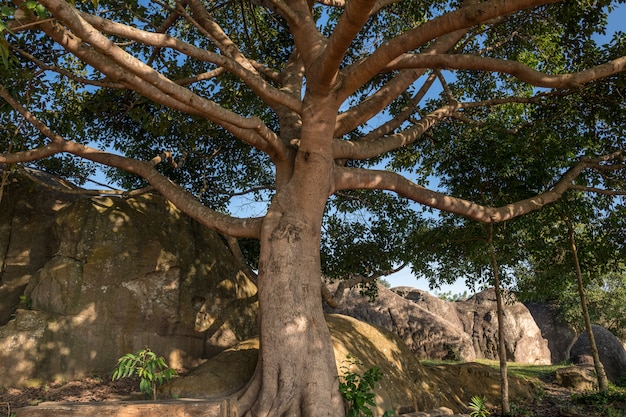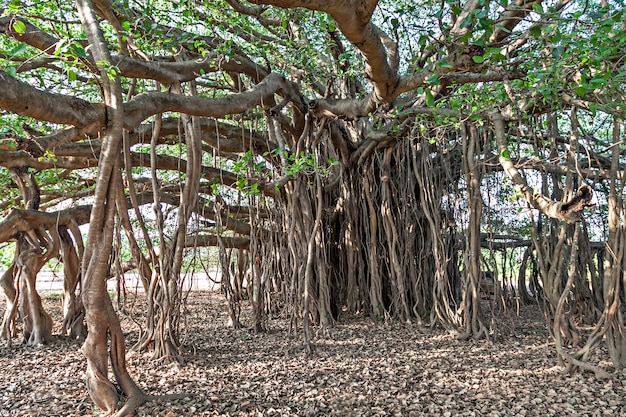The national tree of a country is a symbol of pride which is an integral part of the country's identity. Considered as such, the tree must give tremendous cultural importance through the psyche of the country. Being a native of that country, the privileged status of the tree is considered as a national symbol.
The national tree of India is the banyan tree, formally named as Ficus benghalensis. This tree is considered sacred in Hindu philosophy. It is often the focal point of human establishment due to its expanding form and providing shade. This tree is considered a symbol of longevity as it lives for years and is one of the largest living trees.

The sheer size of the banyan tree makes it a habitat for a large number of organisms. The banyan tree has been a central point for village communities in India for centuries. The banyan tree is not only huge from outside, but it sends new sprouts from its roots, making the tree a part of branches, roots. The Banyan tree extends majestically above its nearby trees and extends to the roots of all known trees, covering several acres. Banyan tree has a long life and is considered an immortal tree.
Banyan trees are one of the largest trees in the world and grow up to 20-25 meters long and extend up to 100 meters with branches. It has a huge furrow with smooth brownish brown bark and is lowered. They have very powerful roots that can sometimes penetrate into very hard surfaces such as concrete and even stones.

As the banyan tree matures, the mesh support of the roots exerts considerable pressure on the tree, it eventually dies and the remains rot, leaving a hollow central column inside the trunk of the main tree. The leaves are thick and erect with small petioles. The leaf buds are covered by two lateral scales that fall as the leaf matures.
It is a type known as osteoles and surrounds both male and female flowers simultaneously at the apex. The fruits of banyan trees are of fig type which are depressed-globose shaped, 15–2.5 cm in diameter and pinkish-red in color, with few outer hairs present.
Importance of Baniyan Tree:
Banyan tree has great cultural importance in India. It is considered sacred among the Hindu population and temples and shrines are built in its shade. The banyan tree usually symbolizes an eternal life because it has a very long life.
Married Hindu women often perform religious rituals around the banyan tree to pray for their husband's longevity and well-being. The Hindu supreme deity Shiva is often depicted as sitting under a banyan tree surrounded by sages and meditating. The tree is also considered a symbol of Trimurti, a confluence of the three supreme deities of Hindu mythology - Lord Brahma is depicted in the roots, Lord Vishnu is considered a trunk and the branches of Lord Shiva.

Facts
1. It often refers specifically to 'Indian Banyan' or 'Ficus benghalensis'.
2. It was adopted as the national tree of India in 1950.
3. Banyan trees can be found throughout the Indian nation.
4. Banyan trees are found in tropical and subtropical parts of India, Pakistan and Bangladesh. 5. hey represent the largest trees in the world by canopy coverage.
6. The name Banyan is derived from ‘Baniyas’, who used to rest under trees to discuss their strategies about trade.
7. The largest banyan tree in India lives in the Indian Botanical Garden at Shibpur in Howrah in West Bengal.It is about 25 meters long and the canopy cover is 420 meters with aerial roots of about 2000 meters.
8. It is a fig that begins its life as an epiphyte (a plant growing on another plant).
9. Banyan tree leaves are large, leathery, shiny green and oval in shape.
10. The leaf bud is covered with two large scales.
10. The leaf bud is covered with two large scales.
11. The huge banyan tree climbs over its neighbors and has the most access to the roots of all known trees.
12. Its shape and leafy shelter are valued as places of rest and reflection in India.
13. The tree of huge size acts as a shield, protecting it from hot sun. This is why trees are planted near homes, temples, villages and roads.
14. In rural parts of the country, the banyan tree is considered the focal point of panchayats and gathering place for village gatherings and meetings.
15. Banyan tree is considered sacred by Hindus. It is also known as 'Banyan', 'Vat' tree and 'Barah'.
16. The tradition of worshiping sacred trees has been prevalent among people since Hinduism, which dates back to the ages.
17. Married Hindu women worship the banyan tree to live long and happy married lives.
18. In many parts of the world, the wood and bark of the banyan tree is used to make paper.
19. Banyan fruits are edible and nutritious. They are also used to reduce skin irritation and reduce inflammation.
20. With high medicinal value, banyan is often used as an herb to treat and cure many diseases.

You can write your questions and thoughts related to this blog in the comment below.
Comments
Post a Comment